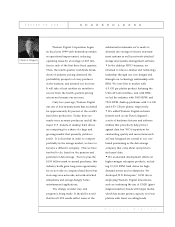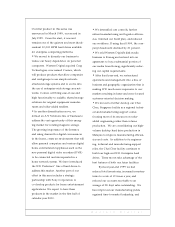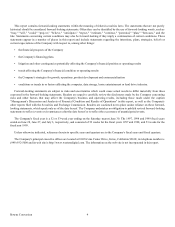Western Digital 1999 Annual Report Download - page 12
Download and view the complete annual report
Please find page 12 of the 1999 Western Digital annual report below. You can navigate through the pages in the report by either clicking on the pages listed below, or by using the keyword search tool below to find specific information within the annual report.Bowne Conversion 7
The WD Caviar product line generally leverages a common architecture or "platform" for various products with different capacities
to serve the differing needs of the desktop PC market. The Company expects to utilize the WD Caviar platform strategy as it develops
products for the emerging market for hard drives specifically designed for audio-visual applications, such as new video digital
recording devices. This platform strategy results in commonality of components across different products, which reduces exposure to
changes in demand, facilitates inventory management and allows the Company to achieve lower costs through economies of scale
purchasing. This platform strategy also enables computer manufacturer customers to leverage their qualification efforts onto
successive product models.
The WD Expert line of hard drives is focused on the higher end of the desktop PC market where capacity per system and
performance are most important. These drives are developed under a hard drive technology licensing and component supply agreement
between the Company and IBM (the "IBM Agreement"). The IBM Agreement enables the Company to incorporate IBM's technology,
designs, and hard drive components into the Company's desktop PC products. The Company believes that access to IBM's hard drive
research and development in 1999 helped the Company achieve its strategy of time-to-market leadership in the desktop PC hard drive
market. For further discussion of the IBM relationship, see Part II, Item 7, under the heading "Risk factors relating to Western Digital
particularly."
Enterprise Products. The Company began shipping WD Enterprise products in fiscal 1997. The Company's current enterprise
products offer storage capacities ranging from 9.1 GB to 18.3 GB, are 1.0" high, use the 3.5-inch form factor, feature seek times of less
than 8 milliseconds, and are targeted at workstations, servers, multi-user systems and storage subsystems. WD Enterprise™ products
utilize the SCSI interface, (both single-ended and low voltage differential) combined with 7200 rpm and 10,000 rpm spin rates to provide
the high performance required to meet the storage needs of enterprise systems. The Company also recently introduced a WD
Enterprise product which uses the Ultra 160 SCSI interface, allowing an internal data transfer rate of approximately 160 megabytes per
second, twice as fast as the previous generation of SCSI interface.
In order to grow its enterprise product revenues, the Company must expand its product offerings to include a broader range of
enterprise products demanded by computer manufacturer customers. These products include FC-AL and other high speed interfaces.
See "Technology and Product Development." The IBM Agreement is not applicable to the Company's enterprise business, so
enterprise product development must be achieved through the Company's own technological developments.
Products for Emerging Audio-visual Markets. Audio-visual applications such as digital video recording devices represent a
developing market opportunity for the Company's hard drive technologies. Hard drive technology makes it possible to simultaneously
record and playback content; to pause, skip forward and backward during live broadcasts; and to rapidly access large amounts of
audio-visual content. The Company offers customized design capabilities and unique hard drive technologies for consumer
applications; however, where practical, the Company intends to leverage its existing product line architectures for the various products
for the audio-visual market. The Company is currently developing hard drives for consumer electronics products with Sony
Corporation, under a strategic alliance between the Company and Sony that was announced in December 1998. The Company is also in
discussions with other consumer electronics companies concerning incorporation of hard drives into new and existing consumer
electronics products. Commercialization of the Sony product is being targeted for calendar 2000. Because the market for these products
has not yet developed, it is too early to project the likely size and growth of such market. For further discussion of this product
development effort, see Part II, Item 7, under the heading "Risk factors relating to Western Digital particularly."
Products being Developed by Connex. Connex is developing a network attached storage appliance featuring a fully integrated
controller, up to six hard drives, an integrated tape for backup, automatic connectivity for remote management, and plug-and-play
installation capability. The system will include Connex's Perspective™ storage management software. The system will be marketed for
use by workgroups and small departments where multiple users access shared data files over a local area network. For further
discussion of Connex, see Part II, Item 7, under the heading "Risk factors relating to Western Digital particularly."
Technology and Product Development
Hard drives are used to record, store and retrieve digital data. Their performance attributes are currently better than removable or
floppy disks, optical disk drives and tape, and they are more cost effective than semiconductor technology. The primary measures of
hard drive performance include:
























